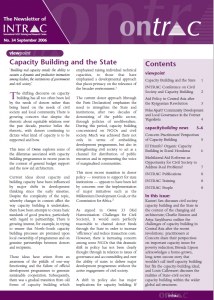 The shifting discourse on capacity building has all too often been led by the needs of donors rather than being based on the needs of civil society and local community. There is growing concern that despite the rhetoric about equitable relations over the past decade, practice belies the rhetoric, with donors continuing to dictate what kind of capacity is to be supported and how.
The shifting discourse on capacity building has all too often been led by the needs of donors rather than being based on the needs of civil society and local community. There is growing concern that despite the rhetoric about equitable relations over the past decade, practice belies the rhetoric, with donors continuing to dictate what kind of capacity is to be supported and how.
This issue of Ontrac explores some of the dilemmas associated with capacity building programmes in recent years in the context of general budget support and the new aid architecture.
In this issue Kasturi Sen discusses civil society capacity building and the State in the context of the changing aid architecture, Charlie Buxton and Asiya Sasykbaeva outline the challenges of capacity building in Central Asia after the recent revolutions, practitioners at Concern share their perspectives on important capacity issues for poverty reduction, Brenda Lipson acknowledges a home-grown, long-term success story that wouldn’t call itself capacity building but fits the capacity-building ideal, and Louis Callewaert discusses the realities of State–civil society capacity building within the wider global aid structures.
Download:
ONTRAC 34. Capacity Building and the State
.pdf (0.94mb)
Download:
ONTRAC 34. Capacity Building and the State. Arabic
.pdf (0.25mb)
Download:
ONTRAC 34. Capacity Building and the State. Chinese
.pdf (0.24mb)
Download:
ONTRAC 34. Capacity Building and the State. French
.pdf (0.14mb)
Download:
ONTRAC 34. Capacity Building and the State. Portugese
.pdf (0.05mb)
Download:
ONTRAC 34. Capacity Building and the State. Russian
.pdf (0.37mb)
Download:
ONTRAC 34. Capacity Building and the State. Spanish
.pdf (0.10mb)